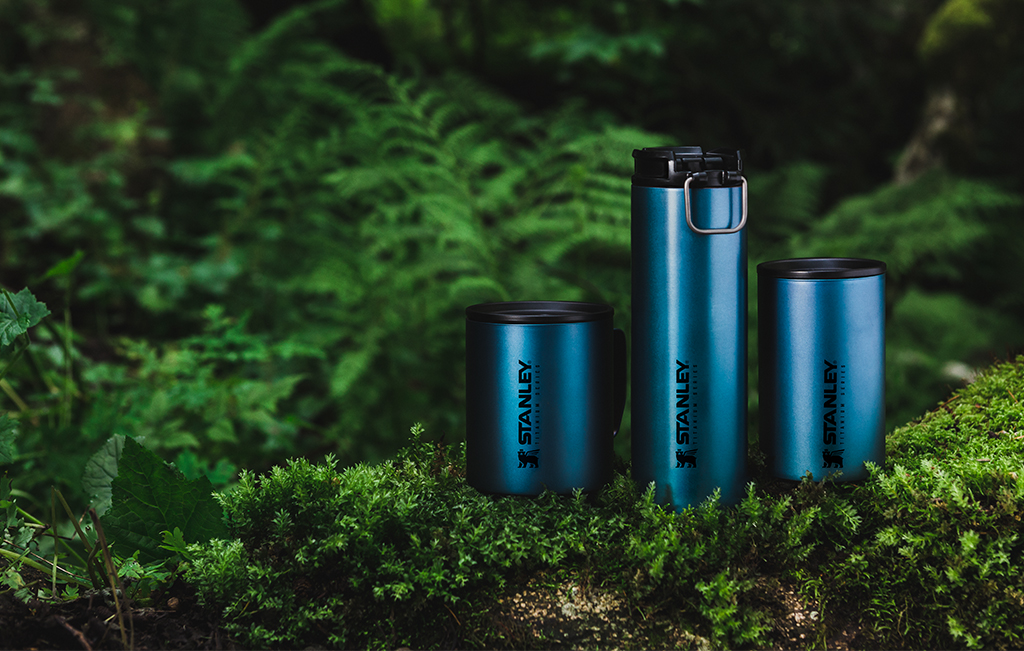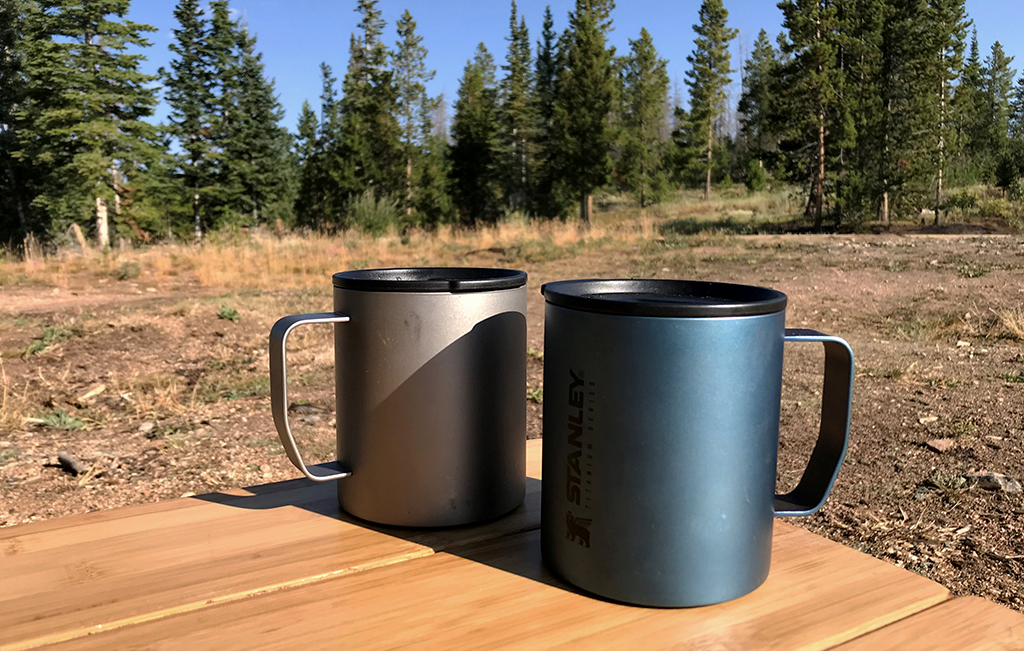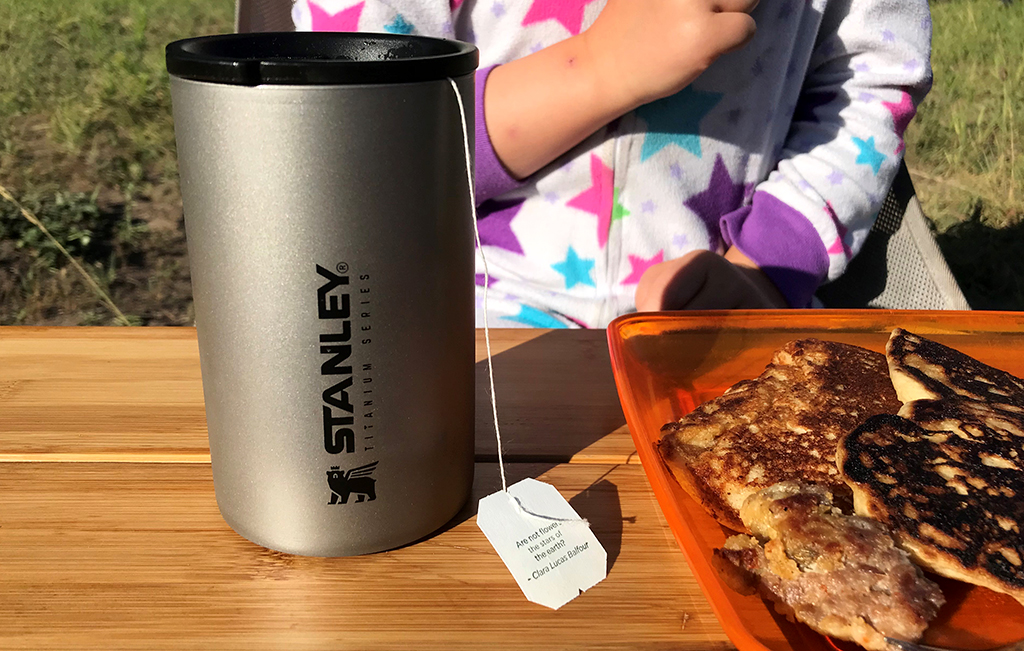Think Stanley, and you probably think steel. But the 107-year-old company has recently released a line of drinkware that’s unlike anything it’s offered before. Stanley’s newest cup and mugs are made of double-wall titanium rather than steel, the metal that the company has used since 1913 to make its unbreakable vacuum-insulated vessels.
So why change up a good thing? The brand hopes that by branching out into a new material, it will appeal to ultralighters who want to shave ounces while still keeping their drinks hot. The titanium line, available exclusively at REI through 2020, features a construction that “lives up to Stanley’s durability promise, while being light,” says Eric Shear, Stanley’s global vice president. “Our titanium pieces are 40 percent lighter than stainless steel,” Shear says.
Titanium’s impressive strength-to-weight ratio has earned it devotees among the fast-and-light crowd, who don’t mind paying a premium for durable pots, cookware and other outdoor gear to lighten their load. Titanium also resists corrosion and exhibits just enough elasticity to flex (not snap) under stress. Plus, says Shear, “Titanium has cachet.”

From left: Stanley Stay-Hot Titanium Camp Mug ($90), Stanley Stay-Hot Titanium Travel Mug ($100), Stanley Stay-Hot Titanium Multi-Cup ($80)
Although titanium may be a new material for Stanley, the double-wall construction isn’t. The company’s founder, William Stanley Jr., invented the first all-steel insulated bottle in 1913. At the time, common vacuum bottles relied on glass, making them too fragile and not practical for ordinary uses, he wrote in his patent application. Instead, Stanley proposed creating an airless layer between two sheets of steel.
Today, the TiVac project draws on more than a century’s worth of knowledge and experience in double-wall insulation, this time using a premium metal—titanium.
The airless gap—rather than the walls themselves—gives double-wall vessels their insulating power. That’s because that vacuum lacks molecules, and the molecule-free barrier prevents energy particles from traveling via convection or conduction (two major forms of heat transfer). The metal walls don’t have to be thick and neither does the vacuum layer (Stanley’s standard is 3mm). Thus TiVac pieces can be appealingly light and sleek.
Titanium may be more expensive than steel, but as the company adapted its double-wall construction methods to the spendier material, it still prioritized its lifetime warranty. The TiVac pieces are also reasonably priced relative to other titanium drinkware options on the market.
The most expensive of Stanley’s offerings, the Stay-Hot Titanium Travel Mug, costs $100 (compared to $160 for a competitor’s slightly smaller version). It comes with a leakproof flip-top cap and holds 14 ounces. Its 2.9-inch diameter makes it slimmer than most travel mugs and cup holder-friendly, and a rubber bottom prevents it from skidding off a table’s surface. According to Stanley, it keeps beverages hot for four hours, cold for four hours and iced for 16 hours.
There’s also the 10-ounce Stay-Hot Titanium Multi-Cup ($80) that pulls double-duty as a portable mug or can koozie (it’s the perfect size for slipping over a cold one). Finally, there’s the 12-ounce Stay-Hot Titanium Camp Mug ($90), which has a removable cap for on-the-go sipping. Both keep bevvies hot for two hours, cold for three hours and iced for 10 hours.
All three TiVac pieces are hand wash-only.

The author’s Stay-Hot Titanium Camp Mugs in the field.
Earlier this summer, Stanley sent me the three new TiVac models to test for this article. I carried them on backpacking trips and stashed them in my camper rig for use on road trips through Colorado and Utah. Each vessel excels in different situations.
The Stay-Hot Titanium Camp Mug, which is suave enough for home or patio use but light enough to earn a place in my overlanding setup, has become my favorite day-starter. The elegantly curved, fixed titanium handle is easier and more comfortable to manage than that of similar mugs that have collapsible handles. Plus, with its beautiful color and modern aesthetic, it makes my coffee ritual a little more special than it was with my former, nondescript vessel. It’s certainly the first piece in my mess kit to “spark joy” in me (de-cluttering advocate Marie Kondo would be proud).
Because of its versatility, the Stay-Hot Titanium Multi-Cup is ideal for trips that call for efficient packing. I fill it with a hot beverage in the morning, and later that afternoon, I rinse it out and slip in a cold can of beer or seltzer. Though it’s far slenderer than the double-wall YETI Rambler Colster that I’ve been using, the Titanium Multi-Cup is just as good at keeping drinks cold (remember: only the vacuum layer provides insulation, not the metal that contains it).

The author’s Stay-Hot Titanium Multi-Cup in the field.
When hiking and bike commuting around town, I reach for the Stay-Hot Titanium Travel Mug. Its slim shape slides easily into the most overstuffed packs, and the leakproof lid has prevented my papers and laptop from getting drenched in hot tea. Plus, it’s ridiculously light at just 8.3 ounces. It’s going to be a must-have during this winter’s backcountry ski tours.
I’ll admit that my husband doesn’t love this mug because the lid’s hinge grabs at his mustache. (The cam-action design opens the drink valve when you flip open the lid.) And the mug’s slender circumference means it doesn’t fit snugly into his car’s cup holder; it tends to bounce out or tip over on curvy roads or bumpy double-track.
Another discovery: After I jammed a few titanium pieces into my camper and bounced along a 4WD washboard for 10 miles, I noticed that one of the titanium mugs suffered a small dent (or “dimple,” as designers call titanium’s little blemishes). Titanium isn’t the hardest metal on the planet, but such dimples don’t compromise the vacuum insulation, says Shear. My testing confirmed as much: The dimpled mug kept coffee just as hot, for just as long as before.
Perhaps the best thing about titanium, at least to appreciators of clean, streamlined design, is the way the material forces restraint. “Titanium can’t be stretched as steel can. It doesn’t want to become a mug,” Shear explains. When some at Stanley suggested adding more features (“more jazz,” as Shear calls it) to the items in the TiVac collection, the metal’s manufacturing challenges thwarted them. The end result: a collection that is the sleekest and simplest that Stanley has so far offered.
